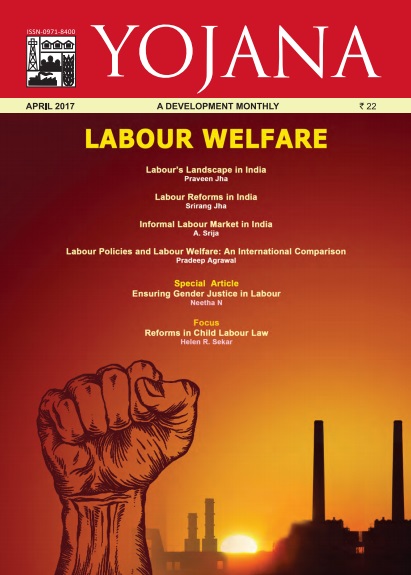(HOT) UPSC Current Affairs 2025 PDF
NEW! The Gist (NOV-2025) | E-BOOKS
(Download) Yojana Magazine Free PDF Archive : April-2017
(Download) Yojana Magazine Free PDF Archive : April-2017
CONTENTS
- Labour’s Landscape in India:
- Praveen Jha -7
- Labour Reforms in India
- Srirang Jha -11
- Informal Labour Market in India
- A Srija -16
Special Article
- Ensuring Gender Justice in Labour
- Neetha N - 21
- Towards a National Policy on Migration
- S Chandrasekhar - 27
Focus
- Reforms in Child Labour Law
- Helen R Sekar - 31
Do you know?
- Labour Identification Number or LIN - 36
- A New Mechanism to Finance Skill Development
- Santosh Mehrotra - 39
- Labour Policies and Labour Welfare:
- An International Comparison
- Pradeep Agrawal - 42
- automation: Challenge to workforce?
- Rintu Nath- 48
- Impact of MGNREGS on Labour Markets
- U Hemantha Kumar, B Sujatha - 52
Labour force has the capability to define the growth and development of any country. It plays the most important role in any economic activity. It is in this context that the labour welfare poses major challenge for the policy makers in any country in terms of creating decent work environment and ensuring well being and prosperity of its labour force.
Indian labour market has a sharp divide between organised and unorganised sector. The small proportion of organised labour enjoys an advantage with stringent laws
and rules and regulations enabling them to fight for their rights. The major chunk however consists of unorganised labour with almost no job or social security. Each
segment of labour whether organized or unorganized, industrial or agriculture, migrant or non migrant has its’ peculiar issues and challenges to deal with. The unorganized sector, whether in the urban areas or rural areas toils hard to help the rich earn huge profit margins and accumulate wealth. Rural unorganized labour on the other hand ends up toiling for the land owner for a mere pittance. The very name – unorganized – symbolizes their state of affairs with their plight being reflected in terms of low wages, bad working conditions and uncertain employment prospects. Migrant labour, moving away from their roots with family, bag and baggage, are found in places far away from where they belong. As construction workers, road workers, household help, they are around us all the time. Women labour constitute another major segment whose work is rarely seen or recognized.
With India poised to have the largest workforce in the world by 2025 it is imperative that labour issues are given the attention and the importance that they deserve. Number of laws viz. Industrial Disputes act, Minimum wages act, Contract Labour Act, have been introduced over the years to take care of various aspects of labour welfare. Most recent ones being The Payment of Bonus (Amendment) Bill, 2015, The Employees’ Compensation (Amendment) Bill, 2016, The Child Labour (Prohibition and Regulation) Amendment Bill, 2016. Ministry of Labour & Employment is now taking steps for simplification, amalgamation and rationalisation of Central Labour
Laws and replacing them with 4 Labour Codes viz. Labour Code on Wages Bill 2015, Labour Code on Industrial Relations Bill 2015, Labour Code on Social Security & Welfare, and Labour Code on Occupational Safety, Health & Working Conditions. Schemes like MGNREGA, Atal Pension Yojana, Pradhan Mantri Kaushal Vikas Yojana Mudra, Pradhan Mantri Rojagra Protsahan Yojana have been introduced to ensure social and economic welfare of existing as well as prospective work force and empower them towards their own well being.
The Government being committed to make India the largest investment destination and the manufacturing hub in the world, attempts are being made to look at labour reforms holistically with intention to make them commensurate with economic growth and ensure labour welfare in it’s true sense.
Click Here to Download Yojana Magazine April-2017
Courtesy : Yojna Magazine


